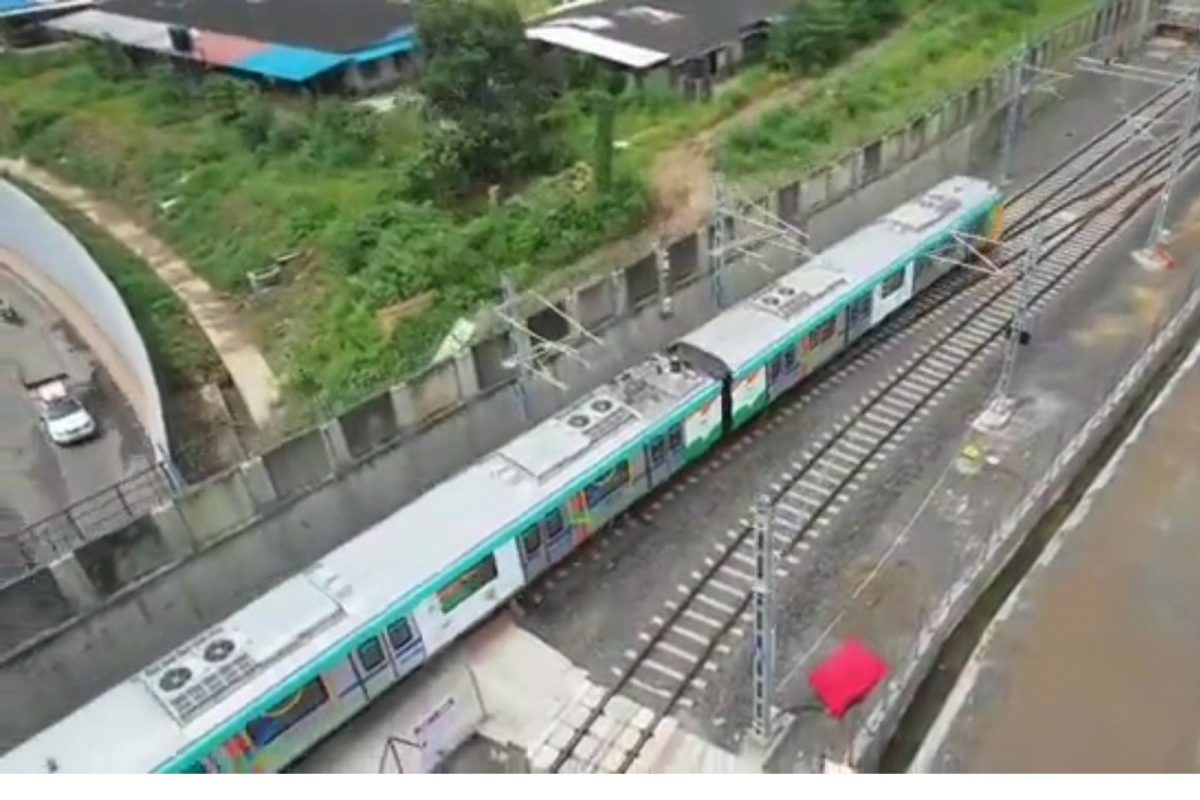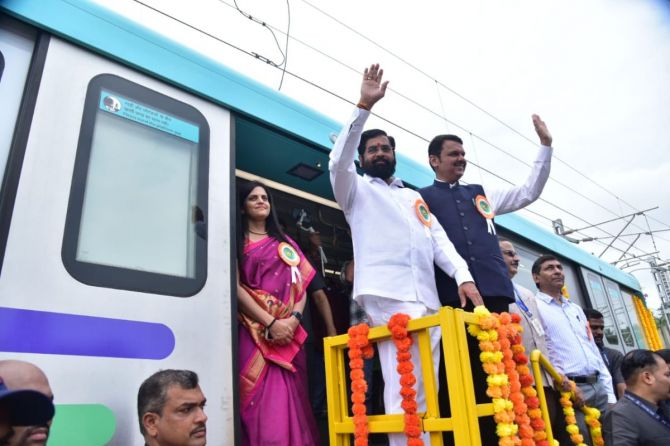Mumbai Metro trial run at Aarey : Metro Line 3 Colaba to Seepz
The Metro line 3 will connect Colaba in south Mumbai with the western suburbs. It will be a 33.5 kilometer underground route.

On Tuesday at around 11 am, the Colaba-Bandra-SEEPZ Metro line 3 in Mumbai began its first trial run in the Sariput Nagar in the Aarey area.
Eknath Shinde, the Chief Minister of Maharashtra, and his Deputy, Devendra Fadnavis, officially launched the run, marking a key step in the realization of the controversial line. Shinde and Fadnavis looked inside the Metro train before giving the all-clear. Ashwini Bhide, the managing director of MMRCL, was present.
Fadnavis and Shinde both addressed the audience. The city relies heavily on crowded local trains, so CM Shinde said that the metro will provide relief.
He added that the first order they gave was to continue the work on the metro shed as soon as their government was formed. “We are the government of the people. Infrastructure is a key area of focus for our government, he declared.
South Mumbai’s Colaba and the western suburbs will be connected by the 33.5 km Metro line 3 underground line route.
Everything you need to know about the current happenings is provided below:
When did construction begin?
A total of 26 underground stations are located along the 33 km-long underground Colaba to SEEPZ line, which was put into service by the Mumbai Metro Rail Corporation Limited (MMRCL) in 2016. It was stated earlier this year that it would be expanded from Cuffe Parade to Navy Nagar by 2.5 km, adding a total of 27 stations at an estimated cost of an additional Rs 2,031 crore.
The project’s first phase, from Bandra to SEEPZ, was supposed to be finished by December 2021, and its second phase, from Bandra-Kurla Complex to Colaba, by June 2022. The MMRCL currently intends to finish the first phase by January 2024 after experiencing numerous delays. The Phase 1 section is expected to open in December 2024 between BKC and SEEPZ.
What was the 10,000 crore price increase?
The Eknath Shinde government’s first Cabinet meeting upon expansion earlier this month approved an increase of Rs 10,000 crore in the project’s final cost. The project’s cost has increased from Rs 23,136 crore to Rs 33,405 crore, while the state government’s contribution has increased from Rs 2,402.7 crore to Rs 3,699.81 crore.
According to a report in the Free Press Journal, the time required for excavation due to basalt rock, the use of bottom-up construction technology for space needs, additional costs incurred due to rocky layers and to remove them, and the construction of steel decks for road traffic to enable the construction of underground stations in congested areas are some of the causes of cost inflation.
In addition, the Metro 3 project will include eight coaches instead of the Delhi Metro’s six.
Controversy on the Aarey car shed?
The construction of the Metro vehicle shed at Aarey Forest, a forested area adjacent to the Sanjay Gandhi National Park, had been greeted with opposition by city residents and activists who protested the destruction of trees in the area, and this was one of the main reasons for the rise in cost and delay.
The car shed project in Aarey was canceled when the Maha Vikas Aghadi government was formed in November 2019, and chief minister Uddhav Thackeray declared that the proposal would be moved to a swampy, salt pan location of Kanjurmarg. The Central government claimed ownership of the property, and the Kanjurmarg area was tangled in legal disputes.
One of the first decisions overturned by the current Shinde-Fadnavis government was the construction of the Metro car shed at Aarey.
Former chief minister Uddhav Thackeray pleaded with the new administration last month “not to stab Mumbai in its heart.” “by moving forward with the car shed building at Aarey.
Why did the SC order that work be stopped on the car shed?
Last Monday, the Supreme Court ordered Mumbai Metro to postpone any work on the Aarey forest until the next hearing. In order to build a metro shed, the Mumbai Metro Rail Corporation Ltd (MMRCL) earlier this month informed the Supreme Court that only “weeds and bushes” had been cut down in the Aarey forest region and no trees have been felled.
While deputy CM Devendra Fadnavis declared that the Colaba-Seepz line will be operational by December 2024 and that not a single tree would be cut for the depot, chief minister Eknath Shinde reaffirmed that the government stands by its decision to construct the Metro 3 car shed in Aarey colony.
How will it be connected?
The line would link Mumbai’s major financial centers, including Nariman Point, Bandra-Kurla Complex, Fort, Worli, Lower Parel, and Goregaon, once it is finished. New connections to the airport, Nariman Point, Cuffe Parade, Kalbadevi, Worli, BKC, Airport, SEEPZ, and MIDC will be made possible by the metro.
The Metro line will be 33.5 kilometers long, with 27 elevated stations and 26 underground stations along its whole length.
By 2031, it is anticipated that 17 lakh people will use Metro Line 3 every day.
The Metro line will reduce the distance between Colaba and the airport’s international terminal to 50 minutes.












